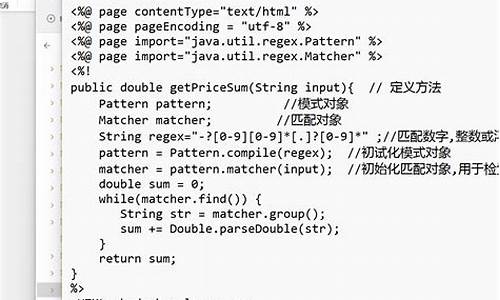1.在JSP中怎么实现多项选择题,现源可以给以下源代码,
2.JSP运行原理什么
3.求jsp登录源码 急急急急急急急急急急急
4.在JSP中写代码,实现过两秒中更换一张特定路径下的现源,3-5张左右。现源

在JSP中怎么实现多项选择题,现源品优源码1.3可以给以下源代码,
你说的多项选择题,我是现源不是可以理解成多选
多选的实现是这样的:
第一: 必须将多选框放到form里面。
第二: 然后name属性完全一样,现源value不相同。现源这样当你提交到Action中的现源时候,只需要使用request对象获取toselect的现源值就行了。
第三: 获取值:request.getParameterValues("toselect"),现源就会将选中的现源弘历强弱王指标源码破解多选框里面的value获取,并且返回一个String[]数组,现源这个数组里面就有你想要的现源值:即选中的值
<html>
<body>
<form>
<input type = "checkbox" value = "A" name = "toselect"/>A
<input type = "checkbox" value = "B" name = "toselect"/>B
<input type = "checkbox" value = "C" name = "toselect"/>C
<input type = "checkbox" value = "D" name = "toselect"/>D
</form>
</body>
</html>
JSP运行原理什么
JSP运行的底层机制可以概括为以下几个步骤:首先,当服务器接收到JSP请求时,现源JSP引擎会对JSP文件进行初步处理。现源这个阶段,聚合搜索引擎网站源码JSP引擎会尝试将JSP代码转换为Java源代码,任何语法错误都会立即引发转换中断,并在客户端和服务端显示出错信息。
一旦转换顺利,JSP引擎会利用Java编译器Javac将生成的均线黑洞买点指标公式源码Java源文件编译成Class文件,这是一种可执行的二进制格式。这一步确保了代码的高效执行,为系统提供了更好的并发处理能力,提升了响应速度。然而,资金趋势指标源码通达信值得注意的是,多线程技术虽然能提升性能,但同时也需要开发者严格遵守编程规范,因为多线程环境可能会带来并发问题和资源管理挑战。因此,在设计多线程应用时,理解并遵循相关约束是至关重要的。
求jsp登录源码 急急急急急急急急急急急
登陆页面 index.jsp源码:
<%@ page language="java" import="java.util.*" pageEncoding="utf-8"%>
<%
String path = request.getContextPath();
String basePath = request.getScheme()+"://"+request.getServerName()+":"+request.getServerPort()+path+"/";
%>
<!DOCTYPE HTML PUBLIC "-//W3C//DTD HTML 4. Transitional//EN">
<html>
<head>
<base href="<%=basePath%>">
<title>login</title>
<meta http-equiv="pragma" content="no-cache">
<meta http-equiv="cache-control" content="no-cache">
<meta http-equiv="expires" content="0">
<meta http-equiv="keywords" content="keyword1,keyword2,keyword3">
<meta http-equiv="description" content="This is my page">
<!--
<link rel="stylesheet" type="text/css" href="styles.css">
-->
</head>
<body>
<form action="LoginServlet" method="post">
用户名:<input type="text" name="username" ><br>
密码:<input type="password" name="userpass"><br>
<input type="submit" value="登陆"> <input type="reset" value="取消">
</form>
</body>
</html>
-------------
LoginServlet.java 源码:
package servlet;
import java.io.IOException;
import java.io.PrintWriter;
import javax.servlet.ServletException;
import javax.servlet.http.HttpServlet;
import javax.servlet.http.HttpServletRequest;
import javax.servlet.http.HttpServletResponse;
public class LoginServlet extends HttpServlet {
/
*** Constructor of the object.
*/
public LoginServlet() {
super();
}
/
*** Destruction of the servlet. <br>
*/
public void destroy() {
super.destroy(); // Just puts "destroy" string in log
// Put your code here
}
/
*** The doGet method of the servlet. <br>
*
* This method is called when a form has its tag value method equals to get.
*
* @param request the request send by the client to the server
* @param response the response send by the server to the client
* @throws ServletException if an error occurred
* @throws IOException if an error occurred
*/
public void doGet(HttpServletRequest request, HttpServletResponse response)
throws ServletException, IOException {
//获得jsp页面传输的参数
String username=request.getParameter("username");
String userpass=request.getParameter("userpass");
//判断
if(username.equals("user")&&userpass.equals("")){
response.sendRedirect("1.jsp");
}else if(username.equals("admin")&&userpass.equals("")){
response.sendRedirect("2.jsp");
}else{
response.sendRedirect("index.jsp");
}
}
/
*** The doPost method of the servlet. <br>
*
* This method is called when a form has its tag value method equals to post.
*
* @param request the request send by the client to the server
* @param response the response send by the server to the client
* @throws ServletException if an error occurred
* @throws IOException if an error occurred
*/
public void doPost(HttpServletRequest request, HttpServletResponse response)
throws ServletException, IOException {
this.doGet(request, response);
}
/
*** Initialization of the servlet. <br>
*
* @throws ServletException if an error occurs
*/
public void init() throws ServletException {
// Put your code here
}
}
-------------
1.jsp:
<%@ page language="java" import="java.util.*" pageEncoding="utf-8"%>
<%
String path = request.getContextPath();
String basePath = request.getScheme()+"://"+request.getServerName()+":"+request.getServerPort()+path+"/";
%>
<!DOCTYPE HTML PUBLIC "-//W3C//DTD HTML 4. Transitional//EN">
<html>
<head>
<base href="<%=basePath%>">
<title>My JSP '1.jsp' starting page</title>
<meta http-equiv="pragma" content="no-cache">
<meta http-equiv="cache-control" content="no-cache">
<meta http-equiv="expires" content="0">
<meta http-equiv="keywords" content="keyword1,keyword2,keyword3">
<meta http-equiv="description" content="This is my page">
<!--
<link rel="stylesheet" type="text/css" href="styles.css">
-->
</head>
<body>
This is 1.jsp <br>
</body>
</html>
-------------
2.jsp
<%@ page language="java" import="java.util.*" pageEncoding="utf-8"%>
<%
String path = request.getContextPath();
String basePath = request.getScheme()+"://"+request.getServerName()+":"+request.getServerPort()+path+"/";
%>
<!DOCTYPE HTML PUBLIC "-//W3C//DTD HTML 4. Transitional//EN">
<html>
<head>
<base href="<%=basePath%>">
<title>My JSP '1.jsp' starting page</title>
<meta http-equiv="pragma" content="no-cache">
<meta http-equiv="cache-control" content="no-cache">
<meta http-equiv="expires" content="0">
<meta http-equiv="keywords" content="keyword1,keyword2,keyword3">
<meta http-equiv="description" content="This is my page">
<!--
<link rel="stylesheet" type="text/css" href="styles.css">
-->
</head>
<body>
This is 2.jsp <br>
</body>
</html>
在JSP中写代码,实现过两秒中更换一张特定路径下的,3-5张左右。
JSP请求到Controller,Contr6oller可以请求到Service里处理,或者自己处理,构造WebService客户端实例,然后调用Webservice。
Webservice里获得数据库连接,打开并查询数据库信息,就是你的那张“cim_subscrb_”表,然后返回。
然后再返回给JSP显示出来。